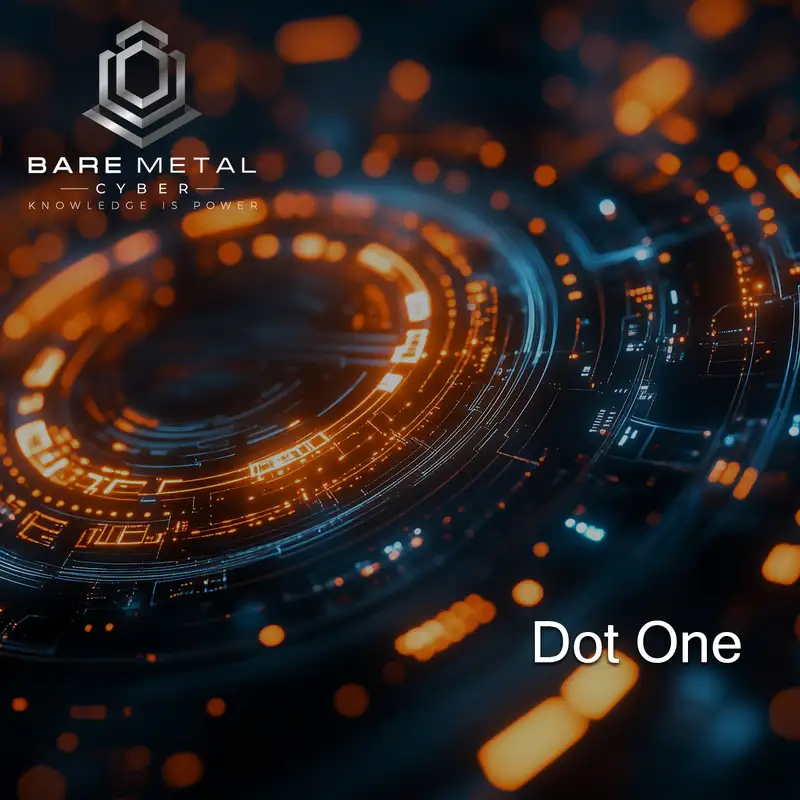The Cybersecurity Maturity Model
Welcome to Dot One, where we break down the key concepts of cybersecurity, making complex topics accessible and actionable. Whether you're an industry professional, a student, or just someone curious about digital security, this podcast delivers insights that help you stay informed and ahead of emerging threats. Each episode explores critical cybersecurity challenges, best practices, and the technologies shaping the digital landscape.
Be sure to check out my author profile at cyber author dot me, where you’ll find books covering cyber careers, governance, risk management, and even cybersecurity in pop culture. But for now, let’s dive in!
And today’s topic is:
The Cybersecurity Maturity Model
The Cybersecurity Maturity Model serves as a structured framework that enables organizations to assess, benchmark, and enhance their cybersecurity capabilities, providing a clear roadmap to strengthen defenses against an ever-evolving array of digital threats. By offering a systematic approach to evaluate current security practices and identify areas for improvement, it guides businesses—from small enterprises to global corporations—toward achieving higher levels of resilience and preparedness in a landscape where cyberattacks like ransomware, phishing, and data breaches grow increasingly sophisticated. Its critical importance lies in transforming cybersecurity from a reactive scramble into a proactive strategy, aligning with compliance requirements such as the General Data Protection Regulation, and empowering organizations to allocate resources effectively to protect sensitive data and critical systems. As of February 28, 2025, with cyber risks intensifying due to advancements like artificial intelligence and cloud adoption, the Cybersecurity Maturity Model stands as an indispensable tool for navigating the complexities of modern security challenges and ensuring long-term organizational stability.
Understanding the Cybersecurity Maturity Model
The Cybersecurity Maturity Model is defined as a framework that organizations use to assess and advance their cybersecurity maturity by evaluating their processes, practices, and controls against defined benchmarks. Its primary purpose is to guide security improvement efforts, helping organizations move from basic, ad hoc defenses to sophisticated, proactive strategies that mitigate risks effectively. The focus lies on structured capability progression, where each stage builds on the previous one, offering a clear path to enhance protection against threats like malware or insider attacks. It supports risk management by identifying vulnerabilities and ensuring compliance with standards like the Payment Card Industry Data Security Standard, providing a holistic view of security readiness.
Key components form the essential structure of any Cybersecurity Maturity Model, enabling comprehensive evaluation and growth. Maturity levels, typically ranging from initial to optimized, indicate capability stages, showing how evolved an organization’s security practices are. Domains or practices, such as risk management or incident response, define specific assessment areas, breaking security into manageable segments. Metrics, like incident response time or patch frequency, measure progress, offering quantifiable data to track improvements. Guidelines, such as adopting multi-factor authentication, provide actionable steps to achieve higher maturity, serving as a practical roadmap.
Common models illustrate the variety of Cybersecurity Maturity Model frameworks available, each suited to different needs. The National Institute of Standards and Technology Cybersecurity Framework offers a flexible, risk-based approach, widely adopted across industries for its adaptability. The Cybersecurity Capability Maturity Model, developed by the Department of Energy, focuses on critical infrastructure with detailed domains like asset management. The Center for Internet Security Controls framework provides 18 prioritized controls, emphasizing actionable steps for resilience. The Cybersecurity Maturity Model Certification, mandated by the Department of Defense, targets contractors with tiered certification levels for protecting controlled unclassified information.
The importance of the Cybersecurity Maturity Model to organizations lies in its transformative benefits for security management. It enhances visibility into security posture, revealing strengths and weaknesses—like outdated patching—through structured assessments. Alignment with regulatory requirements, such as the General Data Protection Regulation or the Health Insurance Portability and Accountability Act, ensures legal compliance via documented improvements. Improved resilience against cyber threats strengthens defenses, reducing breach likelihood with proactive measures. Strategic resource allocation directs budgets and staff to high-impact areas, like endpoint protection, optimizing security investments effectively.
Designing a Cybersecurity Maturity Model
Framework selection kicks off the design of a Cybersecurity Maturity Model by choosing the right foundation for an organization’s needs. Selecting a model based on industry needs might mean the National Institute of Standards and Technology Cybersecurity Framework for a tech firm or the Cybersecurity Maturity Model Certification for a defense contractor, matching sector risks. Assessing organizational size and complexity determines fit—small businesses may prefer the simpler Center for Internet Security Controls, while large enterprises opt for comprehensive frameworks. Evaluating compliance or certification goals ensures alignment, like meeting Department of Defense requirements with Cybersecurity Maturity Model Certification levels. Considering adaptability to future threats favors flexible models, like National Institute of Standards and Technology, for evolving risks like artificial intelligence exploits.
Maturity level definition sets clear stages to measure and guide cybersecurity growth within the model. Establishing baseline capabilities defines the starting point, such as basic antivirus use at an initial level, setting a floor for all organizations. Defining intermediate steps outlines progression, like adding multi-factor authentication at a managed level, building incrementally. Setting advanced benchmarks marks top maturity, such as automated threat hunting at an optimized level, aiming high. Aligning levels with business objectives ties security to goals, like ensuring e-commerce uptime with robust defenses, for relevance.
Assessment methodology crafts the process to evaluate cybersecurity maturity accurately and consistently. Developing self-assessment questionnaires provides tools, like surveys on patch management, for internal reviews by staff. Incorporating third-party audit options allows external validation, such as hiring auditors for Cybersecurity Maturity Model Certification compliance, adding objectivity. Defining scoring criteria sets standards, like a 1-5 scale for incident response speed, for measurable results. Planning reassessment cycles schedules reviews, like annually, to track progress over time.
Integration with security strategy embeds the Cybersecurity Maturity Model into broader organizational efforts seamlessly. Mapping to existing policies aligns maturity goals with rules, like linking data encryption to privacy standards, for consistency. Aligning with risk management processes ties levels to risk scores, such as prioritizing high-risk asset protection, for focus. Coordinating with incident response plans syncs maturity with actions, like ensuring optimized levels include rapid recovery, for readiness. Linking to technology investments prioritizes spending, like funding endpoint detection based on maturity gaps, for efficiency.
Implementing the Cybersecurity Maturity Model
Initial assessment launches implementation by establishing a starting point for cybersecurity maturity within the organization. Conducting baseline reviews evaluates current practices, like checking firewall use across servers, for a snapshot. Identifying maturity levels places the organization, such as at "managed" for basic controls in the National Institute of Standards and Technology framework, setting the stage. Documenting gaps highlights weaknesses, like missing multi-factor authentication, for focus. Engaging stakeholders, from Information Technology to leadership, gathers input, ensuring broad buy-in and accuracy.
Improvement planning charts the path to advance maturity based on assessment findings. Prioritizing gaps by risk impact focuses on critical fixes, like patching vulnerabilities risking data breaches, first. Setting short-term goals targets quick wins, such as adding encryption within six months, for momentum. Planning long-term targets aims higher, like reaching optimized maturity in three years, for vision. Allocating resources assigns budgets and staff, like funding training or tools, to close gaps effectively.
Execution and monitoring put the improvement plan into action with oversight for progress. Implementing upgrades systematically rolls out changes, like deploying endpoint detection across all devices, in phases. Tracking with metrics measures success, such as reducing incident response time from 48 to 24 hours, for data-driven results. Adjusting based on feedback tweaks efforts, like refining policies if staff struggle, for agility. Reporting to leadership shares updates, like quarterly maturity gains, securing ongoing support and alignment.
Continuous improvement sustains the Cybersecurity Maturity Model’s value over time with iterative refinement. Reassessing levels periodically, like annually, checks progress, such as moving from managed to defined in Center for Internet Security Controls. Updating for new threats adapts practices, like adding ransomware defenses, staying current. Incorporating incident lessons refines strategies, such as tightening access after a breach, for learning. Adapting to changes adjusts for regulations or tech, like cloud security shifts, keeping maturity relevant.
Challenges and Best Practices
Common challenges test Cybersecurity Maturity Model implementation across organizations. Resource limitations, like tight budgets or small teams, hinder efforts, delaying upgrades like multi-factor authentication despite need. Complexity of aligning models, such as merging National Institute of Standards and Technology with Cybersecurity Maturity Model Certification, risks confusion or overlap in large firms. Resistance to change from staff or leadership slows adoption, like rejecting new policies for workflow fears. Rapid threat evolution, such as artificial intelligence exploits, outpaces static maturity plans, needing constant updates.
Best practices optimize Cybersecurity Maturity Model use with strategic approaches. Starting with a manageable scope focuses efforts, like applying Center for Internet Security Controls to critical servers first, for early wins. Leveraging automation for assessments uses tools, like Security Information and Event Management systems, to score maturity fast and accurately. Engaging cross-functional teams, from Information Technology to legal, ensures broad input, like aligning with compliance needs. Regularly reviewing relevance updates models, such as adapting National Institute of Standards and Technology for cloud risks, keeping them fit.
Compliance and governance align the Cybersecurity Maturity Model with legal and industry standards. Aligning with General Data Protection Regulation rules ensures privacy, like data deletion processes, meeting European Union mandates. Meeting Payment Card Industry Data Security Standard needs secures payment data, vital for retail with card protections. Adhering to National Institute of Standards and Technology guidelines applies best practices, like risk assessments, broadly. Documenting for audits logs maturity steps, such as policy updates, proving diligence cleanly.
Future trends signal Cybersecurity Maturity Model evolution with tech and threats. Artificial intelligence enhancing assessments predicts risks, like phishing spikes, with smarter analytics for scoring. Integration with zero trust frameworks verifies access at all levels, tightening maturity controls dynamically. Expansion to cloud and Internet of Things security adapts models, like Cybersecurity Capability Maturity Model, for new assets. Focus on supply chain cybersecurity adds domains, like vendor risk, addressing modern interconnected threats.
Conclusion
The Cybersecurity Maturity Model stands as a critical framework, guiding organizations through structured stages to assess and enhance their cybersecurity capabilities, building robust defenses against threats like ransomware or data breaches in a digital-first world. Its impact on providing visibility, ensuring compliance with standards like the General Data Protection Regulation, and driving resilience makes it a linchpin for strategic security, empowering firms to prioritize resources and stay ahead of risks. As artificial intelligence, zero trust, and supply chain complexities reshape the threat landscape by February 28, 2025, ongoing vigilance and adaptation ensure the Cybersecurity Maturity Model remains a vital tool, securing organizations against an ever-evolving array of cyber challenges with precision and foresight.
Thank you for joining us on this episode of Bare Metal Cyber! If you liked what you heard, please hit that subscribe button and share it with others.
Head over to bare metal cyber dot com for more cybersecurity insights, and join the tens of thousands already subscribed to my newsletters for exclusive tips on cybersecurity, leadership, and education.
Want to be a guest on a future episode? Visit bare metal cyber dot com and fill out the form at the bottom of the page—I’d love to hear from you!
Lastly, as the author of several books and audiobooks on cyber topics, I’d be grateful for your reviews. Your support helps this community thrive.
Stay safe, stay sharp, and never forget: knowledge is power!

